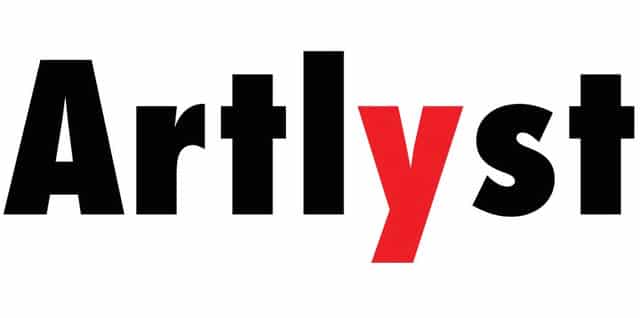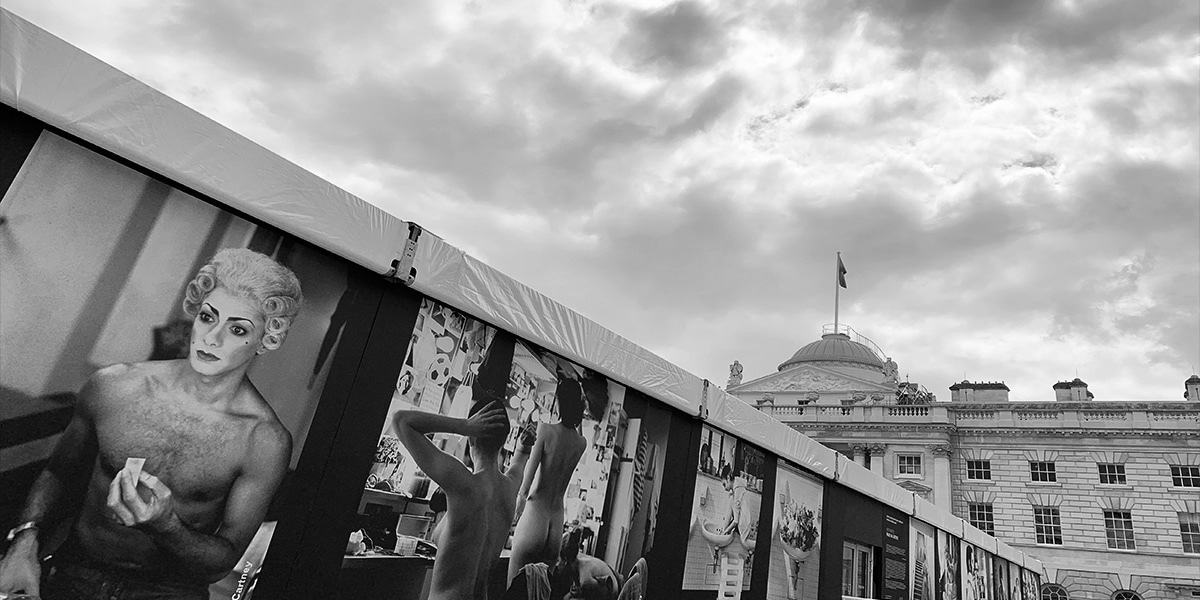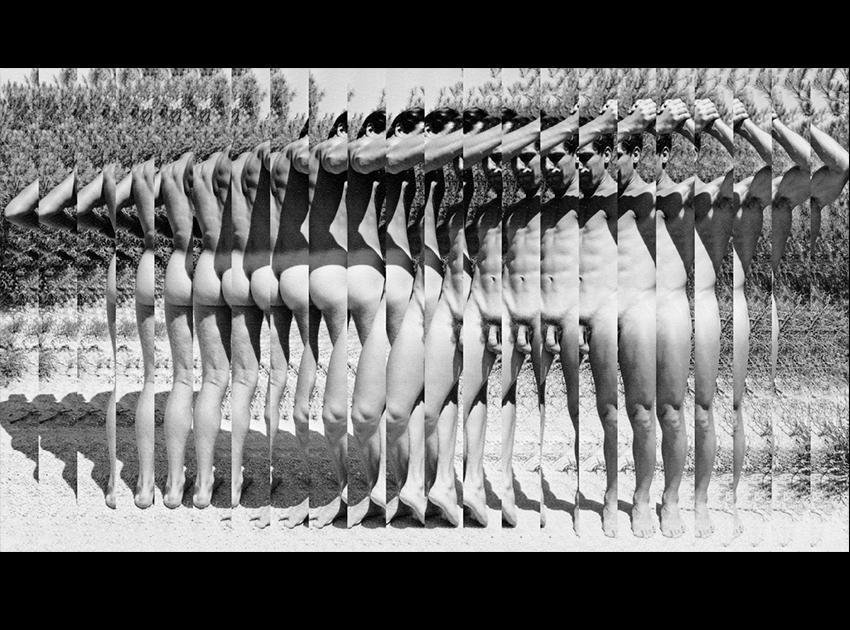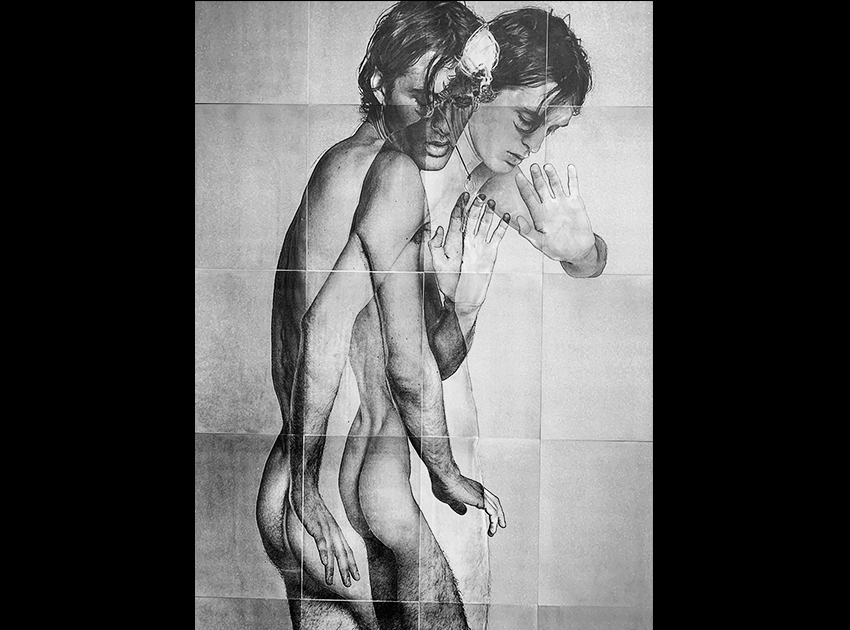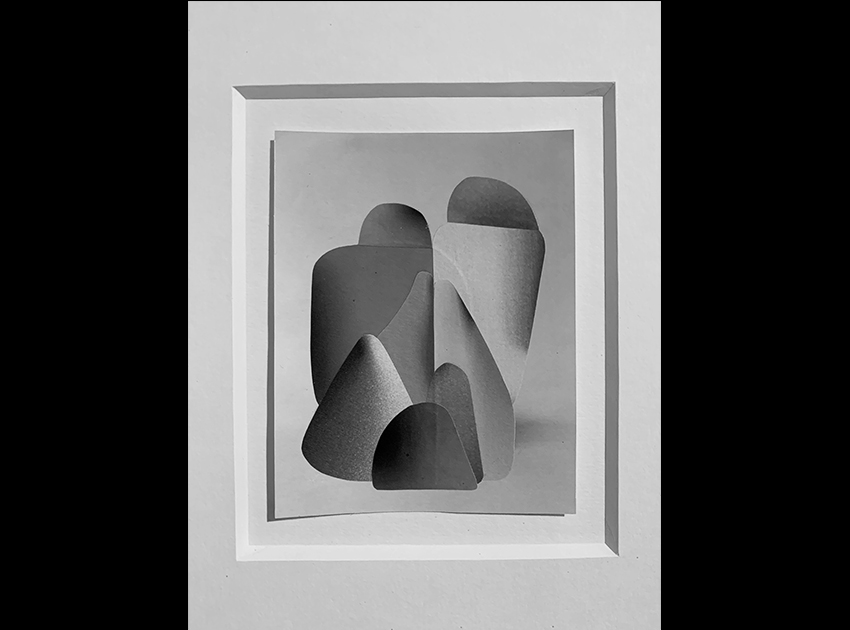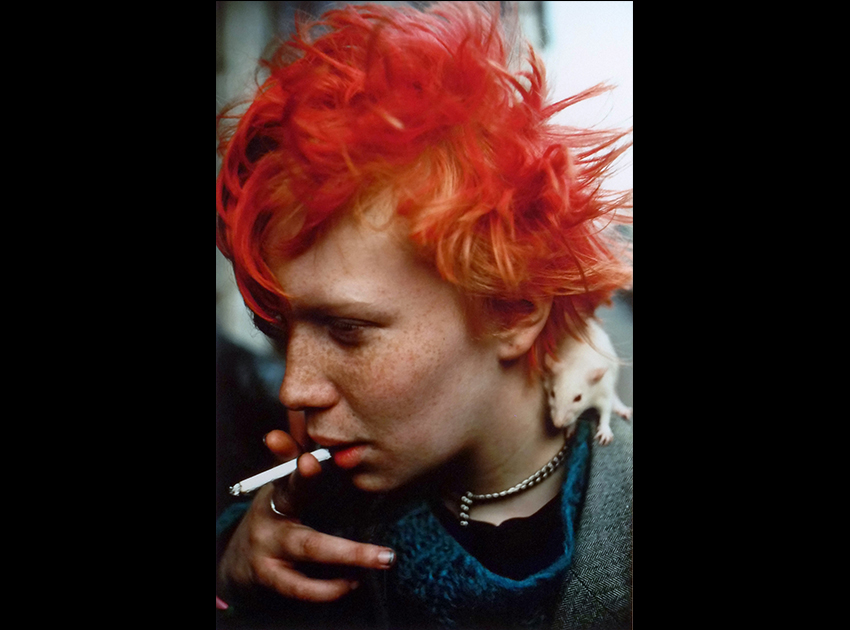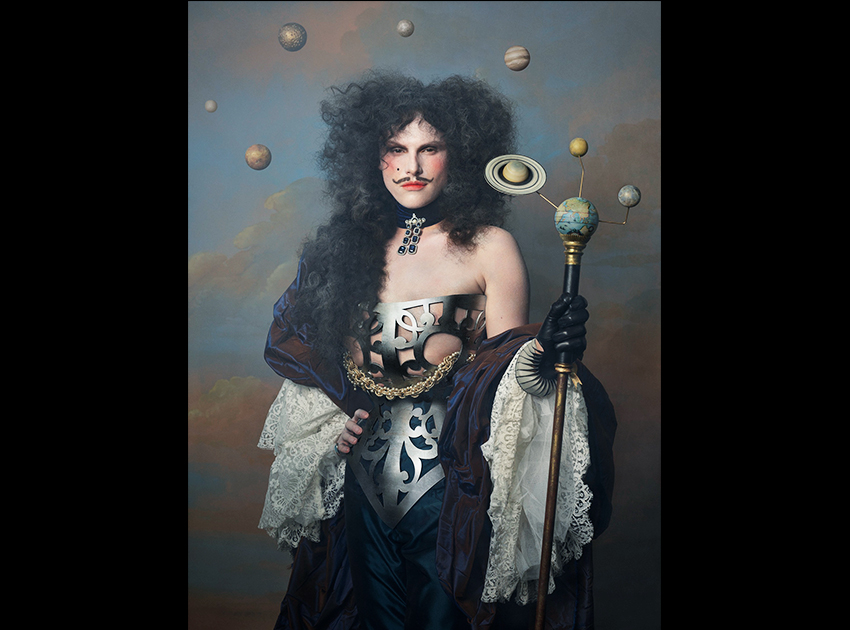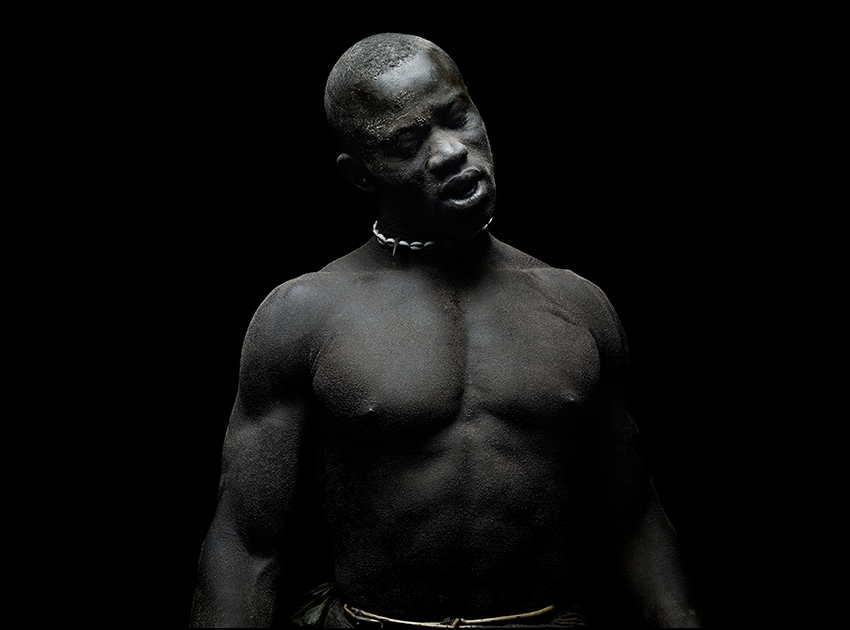The much acclaimed 5th edition of PhotoLondon at Somerset House closed just a few days ago with record sales and robust numbers of over 42.000 visitors in four days. 24 countries and 114 galleries participated, many of them for the first time.
“Landscape-dance, naked bodies, cut-out paper forms and cut-out landscapes,18th-century rebels and 80s red-head punks – that’s PhotoLondon 2019’s palette”
The founders Michael Benson and Fariba Farshad with Giada Vaghi, Head of VIP and Philippe Garner, Chairman of the PhotoLondon Curatorial Committee shared the same opinion:
“Despite the toxic shadow of Brexit, we have emerged stronger than ever. Our team have travelled thousands of miles and worked tirelessly to achieve this outcome. Given the context, this is an extraordinary achievement.”
On the theme of “Women in Photography” the Pavilion Commission demonstrated the Fair’s deep commitment to supporting women photographers. Good news: 40% of the exhibitors and artists were women.
Entering Somerset House through the courtyard Mary McCartney’s large-scale B/W photographs were displayed on the exterior wall of the pavilion. Beside Rachel Louise Brown and Susan Meiselas, the Deutsche Börse Photography Foundation Prize winner, Mary McCartney was one of the three outstanding female artists the Commission featured at PhotoLondon.
As part of the Public Programme Gavin Turk’s project “Portrait of an Egg” was highlighted to question the role of photography and social media in experiencing art. A giant egg was installed on the terrace of the Embankment inviting visitors to take photographs with and of the work, and enter them into a photographic competition on Instagram. Hundreds of photographs were submitted by the public and projected onto the walls of the Great Arch Hall at Somerset House as part of the installation.
Tristan Lund, curator of the Discovery section said:
“This has been the most critically and commercially successful edition of the Discovery section thanks to the daring curation of all 25 galleries including Fernando Bayona by Almanaque Fotográfica (Mexico City), Edouard Taufenbach by Galerie Binome (Paris), Rad Husak by Dellasposa (London), Klea McKenna by Euqinom Gallery (San Francisco), Benjamin Deroche by H Gallery (Paris), Hannah Hughes, Matthew Barnes, Abigail Hunt and Dafna Talmor by Sid Motion Gallery (London) and Marco Maria Zanin by Spazio Nuovo (Rome).”
This year’s PhotoLondon was indeed a superb edition and London has never felt so creative and fluid. I was particularly excited that buyers broke through traditional paths, many of them were young and first-time buyers mixed with major institutional collectors purchasing artworks from Discovery.
Well-before I decided on the core line of this article, I picked some images during the private view and discovered that all of those photographs came from first-time exhibitors and artists. It did not take long to change the format of the article and instead of a short review, I decided to base my words on personal stories, anecdotes and a series of interviews, to dedicate this feature to them, encouraging their work and tireless efforts to participate in PhotoLondon for the first time.
“Etienne danse avec Eadweard” of the series “Spéculaire” by Edouard Taufenbach / Photo © Courtesy of Binom Gallery, Paris
GALERIE BINOM / Paris / EDUARD TAUFENBACH PhotoLondon
At the Discovery section, the Paris based gallery presented a large selection of Edouard Taufenbach’s striking, erotic B/W photographic images. It was his debut in London, however, last year we have already come across with his work in the Curiosa section at ParisPhoto.
In the series of “Spéculaire”, Taufenbach cut his photos into thin slices and meticulously reassembled them.
Z+ “When I look at your photographs it is like looking at an entire movie in a single frame.”
ET “Thank you. In fact, all my life is about cutting and collaging. For my series “Spéculaire” I have collaborated with French film director Sébastien Lifshitz who had a great collection of personal and intimate photos and his homo-erotic, gender issues intrigued me. The original images were often very suggestive, sometimes hard-core and erotic, but the way I reassembled them made the images indirect. My work often questions the boundaries of memory and fiction.”
Valérie Cazin of Binom Gallery carefully listens and takes my microphone for a word:
VC “It’s a great pleasure to be in London, it is our first time. Here, at the Discovery section I found great coherence between the galleries and artists, thanks to the refined curating of Tristan Lund. I have a lot of English collectors visiting us at ParisPhoto, and I always look forward to seeing them in Paris but it gives me a particular pleasure to receive them here in London.
There is also a group show at the moment at the Camberwell College of Arts with Edouard Taufenbach’s photographs in the frame of “Moving the Image”, which states that the photographic image is not at all static, and the contemporary conditions of photography might be best understood through an expanded conception of its actions, gestures and performativities. So we decided to show some of Edouard’s work, which seemed to be the perfect link with PhotoLondon.
It is almost three years that we represent him. His first project was “Cinéma: Histoires Domestiques” at Approche independent art fair and Art Paris with total success and that gave Eduard some free time to prepare his next project “Spéculaire”. It took a year of research and painstaking preparation to put everything together.
I experiment with new exhibitions in my gallery before taking them to such important art fairs such as ParisPhoto. His project was eventually exhibited last year at ParisPhoto in our gallery booth and in Curiosa. We had an immediate and very positive response from the press and art critics, I think we even have yours on our website.”
Z+ “Thank you Valérie, “infinement”, you are a brilliant fast talker, 6minutes 30seconds without running out of breath, that’s quite a record and a great presentation.”
Our time is almost up but Eduard takes me for a quick tour in the gallery to show me two of his favorites. He stops in front of a B/W image, a woman sitting in a garden, her face is sliced by other slices of photographic images of trees and nature, we enter her mind, but also stay aside as a quiet observer, like in a Hitchcockian scene.
On another picture “Etienne danse avec Eadweard” two men are dancing on the beach, there is this magic sequence of movements and intimacy, one of the bodies superimposes on the other and slide-by-slide braids his legs with the others in a slow landscape-dance.”
“Mirrored” by Rad Husak / Photo © Courtesy of ZOLTAN+
DELLASPOSA / London / RAD HUSAK
Next to Binom Gallery at the Discovery section Dellasposa presented another first-timer, Rad Husak.
London based artist, Rad Husak is an intriguing, process-driven character. Fresh from the Royal College of Art, through intensive research and experimentation, Husak defined his own process, the technique of the pigment transfer mixed with carbon-drawn lines on aluminium, often employing the alternative photographic technique of the cyanotype. His work is sensitive, seductive, multi-layered, highlighting the beauty of the male body. With a series of large prints “Mirrored” he debuted this year’s PhotoLondon.
Within his physical and psychological decadent work, Husak brings order into a world that feels chaotic and creates beauty in our vicissitudes of time and history. Blasting through the outer layers of the metal, he reveals his figurative series, where the body is in focus and influenced by the timeless tradition of the Renaissance nude with the ideal of beauty found in sculptures and paintings from ancient Greece and Roman times, combined with a touch of pop culture.
Having long been seduced by the beauty and perfection of his world, Husak walks with me to his pictures presenting his slender, young muses, a model and a dancer in a neo-romantic style.
Whether expressed through figurative or abstract tonal imagery, Husak constructs his series through taking elements from nature, fragmenting and rearranging them, almost to the point of embarrassing and overwhelming the viewer. There is a strong visual game under perfect control of the hand of the artist. Husak is colliding the modern nude male on top of himself in a very contemporary way.
His double exposure images are digital imperfections; the translucent edge of one body blurs and intertwines slowly melting into the other, adding layers of repetition and movements, burning the boundaries of the individual body with multiple possibilities abstracting our vision with his Renaissance orgy.
“Flatland” by Hannah Hughes / Photo © Courtesy of Sid Motion Gallery PhotoLondon
SID MOTION GALLERY / London / HANNAH HUGHES, DAFNA TALMOR
Sid Motion of Sid Motion Gallery is an amazing person, and I have been looking forward to interviewing her for some time.
Z+ “Where are you based in London?”
SM “After having spent some years in Mayfair type galleries, I opened my own three years ago, converting a betting shop at Kings Cross and moved recently to South Bermondsey to join the Peckham art scene. Two of the artists I am showing at PhotoLondon have a studio in South London, so it is really nice to come to the Fair and show artists who are doing something different.”
Z+ “Is it your first time?”
SM “No, It’s my second time, but …”
Z+ ”Oh … in that case, you’re not qualified for my article.”
Sid only takes me seriously for a second then quickly overrides the situation: “So then I am your exception, and also a good fit as my gallery is not only a photo gallery; I am probably exceptional at the Fair in that sense that I brought artists who focus on sculpture, collage and on hand-made work.” … and she is so convincing, how could I possibly argue?
SM “We are showing four incredible artists at PhotoLondon who use photography as a medium: Hannah Hughes, Dafna Talmor, Matthew Barnes and Abigail Hunt.”
Z+ “You are, in fact, representing two of my favourite artists, but I try not to be biased.”
SM “I trust, that one of them is Dafna Talmor? She is a floor above flirting with another gallery, TOBE from Budapest.”
The “Constructed Landscapes”, Dafna’s new series, collages together negatives, and the prints are made through collage-negatives. Each print is an edition of five, but her process is so much about making the collage, it is an experiment, it’s a hand-print. She takes a huge amount of care of getting the master image that I consider her work unique. Her prints are also colourful, sometimes she draws on the negatives where it is going to be cut, and that gives a colour to the print. Often, that is the case of the red lines, where the negatives are not flat to the bedding, the overlapping creates another colour.”
Z+ “… and here is double-agent, Hannah Hughes.”
SM “Indeed, Hannah has two professional lives. She does such a wonderful job for Flowers that she is not very often promoting herself as an artist.”
Z+ “It took me three years to find out who she is.”
SM ”She has been working with paper cut-outs and collages for a long time. I framed up six of them from the “Flatland” series, theses are the “Mirror Images” as sub-series within the series. These pictures shot by Hannah herself and collaged together unlike the previous ones, which were cutouts from various magazines. I was also keen to enlarge her work for the wallpaper, which we tried out together last year and which now definitely gives another layer to our installation.”
By the end of the Fair, all six prints were sold.
“Constructed Landscape NE-040404-1” by Dafna Talmor / Photo © Courtesy of TOBE Gallery
TOBE GALLERY / Budapest / DAFNA TALMOR
I found other Dafna Talmor pictures at Budapest based TOBE Gallery on the ground floor, in a beautiful daylight room. No need to introduce the gallery to Artlyst readers, I have already featured them last year during my trip to Budapest. At that time TOBE Gallery had the tiniest space in the city. Since they moved, they tripled the size of the gallery, invested in an international programme and amongst numerous art fairs in Vienna, Basel, Milan, Arles and Amsterdam they came for the first time to LondonPhoto. The gallery brought female photographers; two Hungarians, Dora Kontha and Anikó Robitz, and London based Dafna Talmor, who is co-represented by Sid Motion Gallery.
TOBE is founded by Caracas-born Tomas Opitz, who is also an art photographer, and by co-founder Bea Puskás. I asked Tomas how they started their gallery focusing on contemporary photography, which is still a fragile subject in Budapest.
TO “The heritage of Hungarian photographers is truly amazing, but those Hungarian artists emigrated a long time ago and built their careers in the West. Indeed, contemporary photography is still a delicate territory in Hungary. It took great consideration and courage to open our gallery in 2013, with the aim to provide the opportunity to present Ibero-American and local contemporary artists. Since 2017, we are in a new gallery space in the heart of Budapest at the Palace district.
I am proud to say that our multi-cultural program brought already many Ibero-American and Hungarian artists together. Our aim is to exhibit young, emerging photographers, to bring them together and send the message out to local Hungarians to give contemporary photography a better value.
We have started looking to represent foreign photographers and Dafna Talmor was recommended by several professionals, both in London and Venezuela. She was born in Israel, brought up in Venezuela, like me, and now lives in London. We connected very quickly with her work. Following her solo exhibition in 2018, we are delighted to bring her series to PhotoLondon. Her photographic work is much-acclaimed; we already received many enquiries, buyers, the Financial Times chose her image to be the “Picture of the Fair” and the Victoria & Albert Museum acquired two of her images recently.”
Z+ ”Someone said that her pictures look like landscapes shot from above but sometimes they look like randomly positioned glass pieces.”
TO “Everything has started with her archive images she has collected over the years in different countries; magical landscapes in Venezuela, Israel, in the States and outside London, but these images are now memories, not so important where they were taken, more like how you relate to them. These two large pictures we brought to London were shot at the same place, one in the US, the other in Israel, focusing on one location and shot on the same roll of film unlike some of her earlier works where she used a montage of different countries and locations.”
Z+ “What are these smaller images?”
TO “These are the “Studies” to show how the process is done. During the process you have to filter the colours, filter the lights. Each frame is filtered differently like a Polaroid proof and that makes her work truly unique”
Z+ “What is the technic she is applying?”
TO “Although we carry a small edition of five examples, her manual process is based on pure experimentation and we could consider each picture as a unique piece of art. She uses medium format colour negatives, slicing and overlaying elements of landscapes, abstracting them beyond recognition, resulting illusionary scenes. The black areas in her pictures are the negative forms; in the printing process during the enlargement the light burs the paper and the area becomes black. When the lines are white, it’s when two elements overlap. You could also detect the cellotapes she uses or the blue lines, which are the guideline markers. All these elements are part of her artwork.
I also want to emphasize that there is no Photoshop or any post-production in her pictures. In fact, this reminds me of the pre-Photoshop era when everything had to be manually put together.”
Z+ “Is it still a secret that I am going to see you at ParisPhoto? Anyway, now it is recorded.”
“Miriam and Bestia” by Philip Pocock / Photo © Courtesy of INDA Gallery PhotoLondon
INDA GALLERY / Budapest / PHILIP POCOCK
On the first floor, I found a red-haired punk girl with a white mouse on her shoulder. She was also a first-timer, at least on paper. She had to wait since the 80s to make it to London although I have already bumped into her last year in Paris at ParisPhoto. She’s Miriam, shot by Philip Pocock, and exhibited by INDA Gallery from Budapest. It is the gallery’s first time at PhotoLondon presenting a handful of Hungarian and foreign photographers including artist Marianne Csáky and her incredible prints, collages and geometrical photographic objects.
I asked the gallery director Daniel Ongjerth to tell me about Miriam’s picture, as my time was limited to one artist only.
DO “Miriam and Bestia” is a powerful picture, shot by Berlin-based photographer Philip Pocock which takes me back to the time I was still living in Berlin finishing off my studies. Philip was born in Canada, moved to New York in 1976, and was recommended by one of the Capa brothers, Cornell Capa, for the Berlinische Galerie to be one of the four photographers to take pictures of the divided city for the 750th anniversary of the founding of Berlin.
I met Philip in Berlin in my local café, we started to talk and when he found out that I was Hungarian our friendship was established right away. The Hungarian influence was quite significant in his life, he told me. His father was a great friend of André Kertész whom he visited several times in New York, Cornell Capa was his first boss for more than 10 years at the ICP, his first photographs were printed at Magnum, which was founded by Hungarians, László Moholy-Nagy had a huge influence on his work as he mainly used daylight for his photographs, read the great writer George Kepes, which helped him with his teaching and 1993 he visited Budapest, met up with artists and photographers and New York-based Hungarian actor Peter Halász.
As a child, he was dyslexic, reading was difficult, so he grew up on the books and pictures of André Kertész and the Capa brothers.
Z+ “How did you end up working together?”
DO “When he came to Budapest he visited INDA Gallery where I was working. I hardly knew, what he was doing for work, he was always very discreet about it. By that time he was exhibiting in Berlin, Basel, Amsterdam, New York, at the Venice Biennale; he was also a good friend of gallerist Monika Sprüth. So we started working together and we exhibited his work in Budapest, also in Paris at ParisPhoto at PRISMS, in the prestigious Salon d’Honneur. Now, it is our first time at PhotoLondon with his photographic series.
Z+ “Is Faliszony a psychological disorder?”
DO “Not really. It was interesting for Philip to discover that Berlin had a new psychological disease, the “wall-phobia”, which is “Faliszony” in Hungarian, and that became the title of his exhibition. He was showcasing the underground cultural life of Berlin, ordinary people, less ordinary people, punks, squatters, urban native artists, graffiti artists, musicians.
“Miriam and Bestia” is a unique piece. It is printed on Cibachrome, which is not produced anymore, the dates are expired on all the papers we could find and it is also toxic, so no further reproduction.”
Z+ “What is the art market like in today’s Hungary?”
DO “It’s very narrow, and although we are one of the most established galleries in Budapest, the market situation under the current political situation is quite complex and difficult. Our artists are, however, not really photographers; they are artists using photography as a medium. In order to run the gallery better, we wanted to step out into the international market with ParisPhoto, Art Dubai, PhotoLondon and many other international art fairs. We tend to be more of an art gallery than a photographer’s gallery.”
Z+ “TOBE?”
OD “Yes, it’s the other Hungarian gallery at PhotoLondon. They are good friends and not only on a professional level but personally as well. They look at art in a similar way although their path is different. It’s good to be friends under the same roof. Art is a narrow market, no place for negative feelings.”
“Monsieur” by Sacha Goldberg / Photo © Courtesy of PROJECT 2.0 Gallery PhotoLondon
PROJECT-2.0 / The Hague / SASHA GOLDBERGER
Under the direction of Coen van der Oever, the Dutch gallery Project 2.0 from The Hague was also a first-timer at PhotoLondon. They brought not one, but two extraordinary photographers from Paris, Sacha Goldberger and Denis Rouvre. Two very different worlds complementing one another.
Living on a spaceship with Louis XIV would have been a perfect place for the immaculately dressed Sacha Goldberger. Although he does not powder his nose like “Monsieur”, he is smart, has great humor and very enthusiastic when it comes to photography. Frankly, I could not decide which was more fascinating, interviewing him with his broken-English and Proustian French or admiring his photographic images.
Z+ “So it’s your first time at PhotoLondon?”
SG “Yes and no. I have been coming to London to exhibit, zo it’s my force time (he probably meant 4th time), but it is my thirst time (probably it reads 1st) with the gallery Project 2.0, showing my new series “Louis-hundred-and-four-teeth” (probably he meant “Louis 114″). In fact – he adds – everything will get better for me for the 5th time which I can pronounce in English without any problem.”
His gallerist, Coen van der Oever is smiling.
Z+ “Cher Coen, how did you meet Sacha?”
CVDO “We’ve met four years ago during ParisPhoto, then Sacha came by to the gallery with his new series and we decided to work together.”
Z+ “Cher Sacha, you are showing four extraordinary characters from the Court of Versailles. Who are these people?”
SG “I put together this new series around Louis XIV with 23 characters and the series called “Louis 114” … hmmm, I think this interview should be called “The 4th of something” it’s full of fours or at least I should be allowed to pronounce it in French.”
Sacha Goldberger likes joking, teasing, but when it comes to his work he changes the tone and becomes convincingly serious.
SG “I am currently showing four characters from my series. One of the women I brought to London, my favourite, is Marie Mancini, niece of the Cardinal Mazarin. She was the lover of the King Louis XIV of France, grew up in Rome in an Italian aristocratic family, and brought to France to marry advantageously. She was the third of the Mancini sisters called the Manzarinettes at the court.
She was my first shot. We worked meticulously on her details, made all the accessories, a special wig, but a bit different from what they were wearing at the time when wigs went up high, really high. We also painted her face like marble and she wore a dress with Saturn around.
The next person is Bonne de Pons, who was one of the royal mistresses of Louis XIV. Her family had her eventually removed from the court and married to the courtier marquees d’Heudicourt, master of the hunt at court.
I made Bonne de Pons wear a gorgeous burnt orange dress with a headpiece. At that time artists often portrayed women with flying fabrics in the air, but I wanted something different, more modern, so we put a round glass fish bowl on her head and laid the fabric on the top of it, which from a distance looked like a frozen motion.
The third person is Vauban, who was a powerful man; France’s leading military strategist and his legacy was his view of France as a geographical and economic entity.
I made him stand in front of a large-scale painted background wearing a glass bowl headpiece with two candles attached to it, looking like a candle-astronaut or if you like, an old fashioned astronaut. I portrayed him with a two-headed dog and a double gun because Vauban couldn’t just have a single gun.
“Monsieur” is my ….. 4th character, probably the most exciting and the most disturbing of all. He was the King’s younger brother, dressed as a girl when he was young because he was afraid that he would be the successor of the crown. He also had some stories with men, acted freely and very effeminately, but married twice, fathered several children and won battles for the King. So, you see the character, not a very simple one. On my picture he strikes a pose as they used to at the time; stiff posture and proudly looking straight into the camera. He wears a metal “bustier”, he is in-between wire and woman, man-woman and fluidity … perfect for London.”
Z+ “You had an extraordinary casting.”
SG “In fact, the whole series is about how Louis XIV and his court would see the future. First, we had to find 23 people who looked like the real characters. Some were famous actors, Pierre Richard as Cardinale de Mazarin, Aurélie Dupont as Mlle de Fontanges, Vincent Perez as Louis XIV, Amira Casar as La Reine d’Espagne, some other characters came from “casting sauvage” and from model and acting agencies.
Not just our casting was very precise, but we made all the accessories for the photo-shoot ourselves. Everything was hand-made except maybe the two-headed dog, but after a long research, we realized that there was no such creature available, so it had to be Photoshopped. It is, however, important to say that we paid special attention to make everything authentic and real as nowadays everything is so Photoshopped. The only exception will be my next project with extraterrestrials as we might not be able to find them by our shooting day.
Z+ “I heard you also had a large crew.”
SG “We had 6 months research, 65 people on the project, 10 of them only for the costumes, another 10-15 on hair, make-up, styling, another 10 on the objects, and so forth, not mentioning the endless planning and a tiresome production.”
Z+ “I might be telling a secret, but you even photographed your grandmother, Mamika, who already had her 100th birthday. Her picture looks amazing, but we have to wait for your 5th exhibition to reveal it, haven’t we? What a beautiful present. Thank you, Sacha.”
“Lamb” by Denis Rouvre / Photo © Courtesy of Project 2.0 Gallery PhotoLondon
PROJECT-2.0 / The Hague / DENIS ROUVRE
Although I missed the book signing of Denis Rouvre, Coen van der Oever of Project 2.0 Gallery gave me a beautiful signed copy. We met over the weekend for a talk.
Z+ “Only a few steps away from Louis XIV extraordinary images you are showing a piece of Senegal.”
CVDO “I am presenting an internationally renown French photographer Denis Rouvre with his series “Lamb” of wrestlers from Senegal (name of the Senegalese wrestling in Wolof language), portraying traditional wrestling and bare hands boxing, which have risen to epic heights.
I’ve come across with his work more than 10 years ago at Hasselblad Masters Award; I called him and asked if he’d like to be represented in the Netherlands. He was already a well-known photographer working for magazines in fashion and portraiture with an impressive portfolio including Sony World Photography Award, Hasselblad Master Award and a World Press Photo Award.
So the following day I drove to Paris to meet him. Our first collaboration was in Amsterdam with a solo exhibition, then last year I showed the “Sadhou” series about holy Indian men at ParisPhoto. He is currently working on a completely new series, “Ground Zero”, and recently had an assignment with five continents to photograph mistreated women in refugee camps from all over the world. This will be a travelling exhibition, not a commercial one, starting this November in Paris.
Z+ “I had the pleasure to admire the series in Paris during ParisPhoto and I am delighted that you are debuting at with this new selection.”
CVDO “Lamb” is an older series but these particular images I brought to LondonPhoto have never been shown before. These are strong images. It took him four years to make them, to have the right context and have the trust of the athletes to pose for him.
Z+ “What’s the history behind Lamb?”
CVDO “Historically, Lamb was played during the harvest though in recent decades it became a national spectacle of urban life and these epic battles drew throngs of spectators, shamans, musicians, sponsors, media and promoters to feverish matches where legends were born. The contest places two amulet-wearing opponents into a sandy arena. Before stepping in, each wrestler meets his Marabout. In order to give them strength, the Marabou will pour milk on the wrestlers’ torsos, their shoulders, their heads, and start singing the ritual words to cast evil spells away.
In the hidden training rooms in Dakar, the wrestlers come every night with a dream and ready to take a lot of beating. They live on small jobs and are burning to strive against their sociological and human conditions. They want to become famous and superhuman. Here everyone aspires to become a King, a living God.”
Z+ “Where were these wrestlers photographed?”
CVDO “He photographed the wrestling apprentices, the tense, perpetually defiant faces, the youngsters’ groups, the World Champions in the suburbs of Dakar. There were probably 200 shouting children as it was a novelty event. He set up a black fabric on the beach like an open-air studio. The lighting was just perfect. Look at the texture of their skin with the sand, it is matt, black, almost like bronze, simply mesmerizing.”
“Sleeping Man” by David Goldblatt / Photo © Courtesy of Goodman Gallery PhotoLondon
There is a reason why I left David Goldblatt’s photographic work last.
Goldblatt captured the understated unease of living an ordinary life in a society under the Apartheid regime in South Africa, “the banal normalities of white madness” as he put it. His images carry a message, which is unfortunately still appropriate today, not so much in a geographic sense. It’s more like a worldwide issue. His photographs are powerful reminders that while ordinary people go about their daily lives, atrocities are committed in their name. His images are a warning that awful things could happen on a normal day. It will take generations to undo the consequences of the Apartheid regime or any racial issue wherever you are.
Jessica Cohen, head of communication of Goodman Gallery received me for a talk.
JC “Goodman Gallery is one of the most distinguished international contemporary art galleries established in Johannesburg in 1966 then later in Cape Town, working with southern Africa’s most significant artists, both established and emerging, who have shaped the landscape of contemporary art from the greater African continent, within the Diaspora.
At PhotoLondon we had a very large, open stand, and we are not showing just a single artist, who we have been representing for a long time, the legendary South African photographer David Goldblatt, died almost a year ago, but actually showing just one series of work by him “The Particulars”, to give the opportunity to visitors to get engaged with his work.
It’s worth saying that last year, just before his death, he had several major exhibitions including Pompidou Center in Paris, MCA in Sydney, ParisPhoto in Paris. This body of work was created in 1975 and you got to put yourself in the context of the depth of the Apartheid regime, which officially has been going for almost 30 years from 1948. David Goldblatt was chronicling the structures he looked at all around him travelling and traversing South Africa and sought to define the values of the Afrikaners set up of the Apartheid regime. This series is his decision to deviate from the heavy expectations of wilding his lens in a political manner, to decide to be lyrical and focus in on people’s bodily particulars; a lovely, old fashion, repressed way of saying, he wanted to close in on areas that we find sensual, sexual, provocative, in the context where sexuality and racial relationships were so heavily controlled.”
At this point Jessica takes me to a picture called “Woman on a bench”, taken in 1975 in Jubers park, Johannesburg.
JC “I think this picture says it all. We see a woman sitting on a bench in a public park during the Apartheid era. The picture focuses on the bottom part of the body, no cropping; this is how the photographs were taken, in fact, we don’t see any faces in the series. The woman’s hand clenches over her crouch, her knees are tied together, her legs are twisted … she is alone and feeling very uncomfortable.
She’s probably on the top of the food chain, a white person who’s allowed to sit on the bench, but she has a very tense body. It was a time of deep tension in society. What’s left out of the frame is the signage, which said “EUROPEANS ONLY” … and for the rest, the blacks were expected to lie on the grass. This is how they controlled people’s interaction.”
Z+ “It’s so hard to comprehend.”
JC “But let me take you to another picture, here we have another story, a white person, shot in 1975, sitting in the same park, but what we see immediately is that a man is seriously spreading his legs in very short, tight shorts and we have this – how shall I put it – tension around his crouch, where Goldblatt zoomed in directly right at his groin.”
Z+ “Let’s walk now to my favourite picture to the “Sleeping Man”.
JC “It’s interesting that this image, the “Sleeping Man” was shot at the same park, probably on the same day, however, it carries very different feelings and connotations. It’s a black person lying on the ground, on the ruff, hay-like, African grass, taking a nap on the beating sun. He looks peaceful, but the stain on his jacket evokes another layer to the story.
Goldblatt refused to belong to any political organization and argued that his anti-Apartheid photographs should not serve any propaganda purposes. He was not interested in front line photography of the protests and violence where we often saw black bodies lying on the ground, shot at the back with a lot of blood and even though this picture looks peaceful, the stain on his back evokes those violent images.”
Goldblatt became the first South African artist to have a solo exhibition at The Museum of Modern Art in New York and decades ago he founded “The Market Photo Workshop” school to help, encourage and educate young photographers.
TOP PHOTO: PhotoLondon, Somerset House, exterior photographs by Mary McCartney / Photo © Courtesy of ZOLTAN+
Text and photos by courtesy of Zoltan Alexander © ZOLTAN+ MEDIA London © ArtLyst

